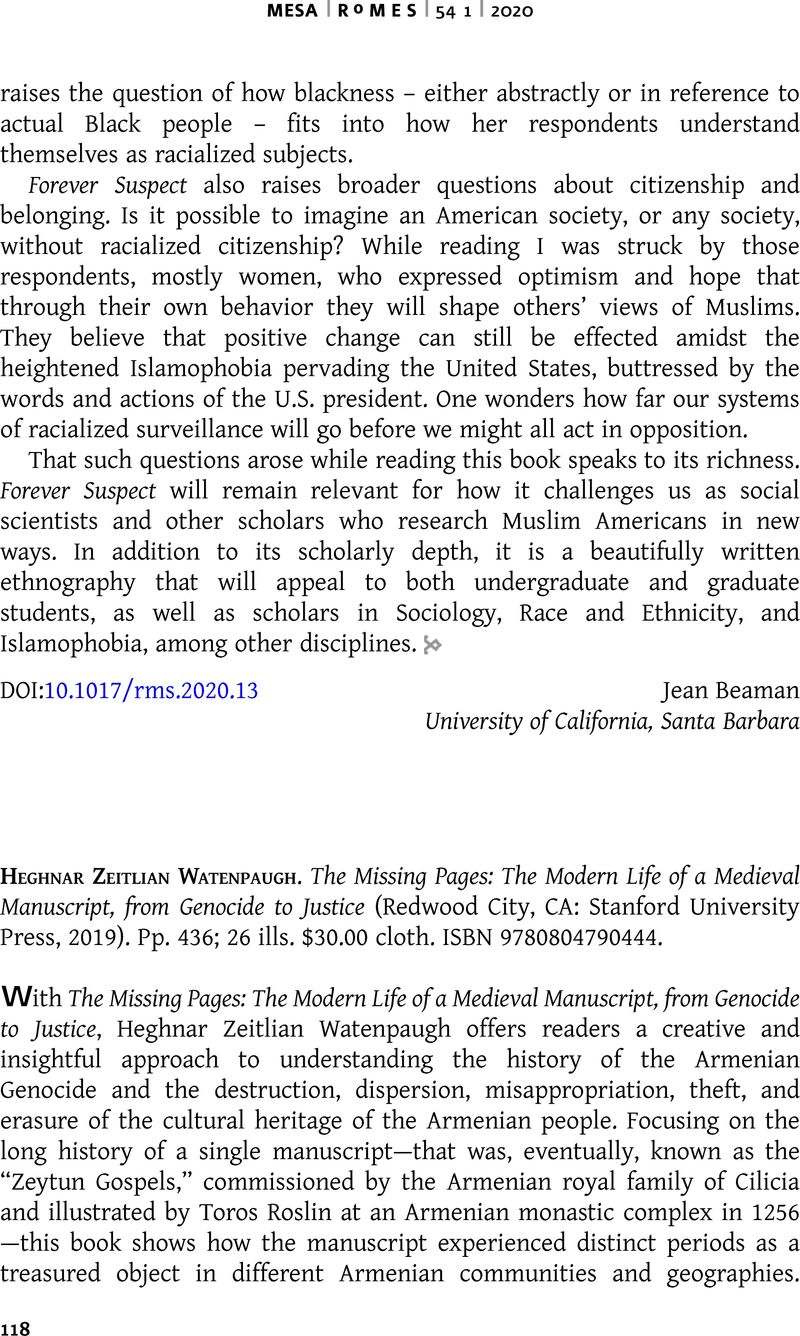No CrossRef data available.
Article contents
Heghnar Zeitlian Watenpaugh. The Missing Pages: The Modern Life of a Medieval Manuscript, from Genocide to Justice (Redwood City, CA: Stanford University Press, 2019). Pp. 436; 26 ills. $30.00 cloth. ISBN 9780804790444.
Review products
Published online by Cambridge University Press: 21 October 2020
Abstract

- Type
- Book Review
- Information
- Copyright
- Copyright © Middle East Studies Association of North America, Inc. 2020
References
1 Said, Edward, Representations of the Intellectual (New York: Vintage, 1996), 15Google Scholar.
2 See, for example, Suciyan, Talin, The Armenians in Modern Turkey: Post-Genocide Society, Politics and History (London: IB Tauris, 2016)CrossRefGoogle Scholar.
3 Levon Ter Petrossian has shown that the Kings of Cilicia were considered “the kings of all Armenians (hamayn hayut‘ean t‘agaworner).” See: Levon Ter Petrossian, The Crusaders and the Armenians: a Historico-Political Study (Xač‘akirnerə ew Hayerə: Patma-k‘ałak‘agitakan hetazotut‘iwn), vol. 2 (Yerevan: Armenian Library of the Calouste Gulbenkian Foundation, 2007), 206. For example, he notes that 13th-century chronicler Kirakos Gancakec‘i relates that when members of the Zakarid dynasty at Ani wanted to build and use transportable alters for their armies (patterned after their Georgian neighbors), the urban leadership of Ani decided it was necessary to request permission both from the Armenian Catholicos and from the King of Armenia. See: Kirakos Gancakec‘i, Patmut‘iwn hayoc‘ ašxatasirut‘eamb K.A. Melik‘-Ōhanjanyani (Erevan: Haykakan SSṚ Gitutʻyunneri Akademayi Hratarkchʻutʻyun, 1961), 166–169; Robert Bedrosian, Kirakos Gandzaketsi's History of the Armenians, (New York: Sources of the Armenian Tradition, 1986), 130–133. Similarly, with regard to geography and governance, as Robert Bedrosian has shown, for most Armenian scholar-clerics political boundaries were less important than the demographic ones, so much so that the thirteenth-century scholar Mxit‘ar Goš created a new term to designate parts of Armenian-inhabited lands to the South of the “Armenian homeland”: “meso-Armenia” (or, mijnahayk‘). See: Robert Bedrosian, Armenia and the Turco-Mongol Invasions (Unpublished PhD dissertation, Columbia University, 1979), 91, n. 161. Arakk‘ Mxit‘aray Goshi (The Fables of Mxit‘ar Gosh) (Venice: San Lazzaro, 1854) 160.
4 See, for example, Sanjian, Avedis K., Colophons of Armenian Manuscripts 1301–1480: a Source for Middle Eastern History (Cambridge: Harvard University, 1969)CrossRefGoogle Scholar, introduction and especially 8; A.S. Matevosyan, Hayerên Tserakreri Hišatakarannerə, E-ZB dd. (Colophons of Armenian Manuscripts, 5th-12th centuries) (Erevan: Haykakan SSṚ Gitutʻyunneri Akademiayi Hratarkchʻutʻyun, 1988), ZE-ZT. For inscriptions, see: H.A. Orbeli, Divan Hay Vimagrut‘ean, Prak I: Ani Kałak (Divan of Armenian Epigraphy, vol. 1: the City of Ani), (Erevan: Haykakan SSṚ Gitutʻyunneri Akademiayi Hratarkchʻutʻyun, 1966), introduction and 134. On the relationship between the written and oral texts in Armenian inscriptions and the ensuing complexities of understanding power relations and centralities, see: Christina Maranci (2006) “Building Churches in Armenia: Art at the Borders of Empire and the Edge of the Canon”, The Art Bulletin, 88:4, 656–675, DOI: 10.1080/00043079.2006.10786313. See, also, Timothy Greenwood, “A Corpus of Early Medieval Armenian Inscriptions.” Dumbarton Oaks Papers 58 (2004): 27–91. Accessed May 19, 2020. doi:10.2307/3591380. Greenwood investigates the webs of meaning projected and reflected by the inscriptions within a complex network of powers: Armenian, Byzantine, Persian, and Islamic.
5 Holsinger, Bruce W., “Medieval Studies, Postcolonial Studies, and the Genealogies of Critique,” Speculum 77:4 (2002):2016CrossRefGoogle Scholar.




